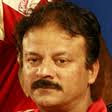By Vikram Afzulpurkar
The seeming invicibility of the 'World Champions' and number one side has been shattered by a doughty opposition in heavy weather
The Mighty Will Fall
Cricket is a great leveller and yes, England defeating India comprehensively in the first Test at Lords, shows how the Asian champion side can capitulate. The latter’s feeling of superiority before the start of the match was from several events, one among them the World Cup victory earlier this year. No less their number 1 status in Tests till then.
The Asian Tiger’s focus has been on T20’s and for good reason because the global game’s revenues will be derived from this format. In conclusion a suitable compromise must be found to accommodate the interests of both the superfast format and its age old ancestor, Tests.
 |
| Judging the ball is a whole different art in England |
Test Focus
Possibly, a byproduct of the T20 emphasis has been an unpreparedness to identify players who will perform well in Tests in England in particular. We’re back to square one, the age old lesson that the ball does very different things in England and that too late in the day. “Bowlers always have a chance,” as an astute sub continental commentator put it, unlike back home where they have to take initial advantage and the batsmen on their part stave off initial dangers.
While there is no doubt that the selectors and coaches know who the good Test players are, one wonders if the entire focus of the Board of Control for Cricket in India and the cricket loving public has been too much towards the faster formats. The BCCI’s intellectuals too must be fatigued. And suddenly, come July (no doubt there was the Test series in the West Indies prior to this) we need a side that takes on a very strong England team and that too in conditions very challenging for batsmen.
BCCI Test Division
Can the BCCI field a talent scouting unit that focuses only on upcoming Test match players? Search the mofussil areas, scour the cities, maybe even stage a Challenger Series (now renamed NKP Salve series, started in the early ‘90s as a selection tournament and comprised India, India ‘A’ and India ‘B’ sides) to select Test players?
Emerging Arena
At the moment, the Test-mettle players in the Indian team, barring Rahul Dravid and Sachin Tendulkar from an earlier era, may be those churned out from one-day selection. Yes, the latter have sufficient class and have been made to gravitate towards what is regarded as the ultimate test for a cricket – Tests.
Seclude and Exclude
However, if their skills are more towards the fast formats, can they not be reserved only for T20s and 50-overs matches? Therefore, others can play when India tour England or Australia where the physical conditions require the pure grafter.
 |
| Shot making is not easy in some conditions |
Aggressive Test approach
Agreed when playing in conditions more suitable for their game, India can select two or three fast scorers to force the pace and give their bowlers more time to bowl out the opposition. Somehow we don’t think this way when playing in England, right?
Perfect Steed
Of course this theory begs many questions, one among them, ‘Batsmen apart, what defines a Test bowler?’ While bowlers may be more pliable between the slow and fast formats, perhaps Praveen Kumar is an example of a genuine swing bowler capable of doing greater damage in than others in Tests in English conditions. By that dint, Ishant Sharma may turn out to be the ideal choice to play in Australia where the pitches almost ‘invite’ you to ‘hit the deck’ and bounce the ball either into or away from the batsmen.
The discussion then looms to what type of spinner is suitable for Tests, that is, if we haven’t tired him out enough in T20s and ODIs. There seems to be no pure rhythm bowler among the spinners that India currently have, therefore there’s no harm in sticking to Harbhajan Singh. He relies on variations and surprise balls to claim wickets.
The Purebred
 |
| Find pure Test players? |
But what if we scouted for a pure rhythm bowler among our domestic leagues? It might give Harbhajan a mental rest window and keep him incisive for the faster formats. Again, it’s a good point at which to reflect. What are we telling our upcoming young bowlers in domestic cricket “Get ready for all formats of the game?” Or are we better off spotting one or two and telling them to “get ready only for Test cricket?” Can a cricketer who is promised nothing but Test cricket become our match winner in alien conditions?
Planning
No doubt it’s only a worthy debate and not practical to make full scale changes in the team right now. But can years of advance planning give us some elusive Test victories in challenging conditions. The previous series in England was no doubt won with Dravid at the helm, but let’s not forget it could have ended up as drawn if MS Dhoni and Sreeshant hadn’t plodded on till the end when 9 wickets were down.
Importance of Tests
Again, in conclusion, India is doing well in the global game, especially the eye grabbing formats of T20 and ODI. But we don’t feel like masters when suddenly upstaged in Tests in difficult conditions. Do we pay heed to the older folks advice about the important of Tests and do something big to arrest this fall? Or do we regard the faster formats as our bread and butter and give only our spare time to developing out Test side?










